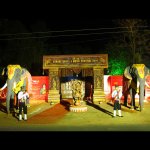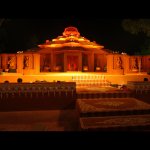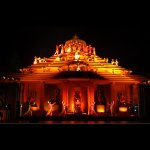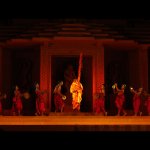
29th edition of Guru Gangadhar Pradhan’s Konark Dance and Music Festival
Text & pics: Lalitha Venkat
e-mail: lalvenkat@yahoo.com
February 26, 2014
Odissi Guru Gangadhar Pradhan was a pioneer and visionary whose passion
was to provide a platform for practitioners of Indian art forms to
promote the cultural heritage of India through his foundation. At his
Konark Natya Mandap located in the village of Konark that is about 90
minutes drive from Bhubaneswar, he built an exotic stage replicating the
tower of the Konark Sun Temple that is just 10-minute walk away.
Sculptures of beautifully proportioned female dancers and musicians
adorn the backdrop and the overall natural terracotta color of the open
air stage set amidst a grove of trees lend an exquisite ambience that
would gladden the heart of any performer. Among the many festivals
Gangadhar Pradhan organized at his mandap through the year, he launched
the Konark Dance and Music Festival that is still a fest to be reckoned
with even after his demise 5 years ago with his only son Sibashish
Pradhan valiantly continuing the tradition. The festival takes place
every year from February 19 to 23 and features classical music and dance
as well as folk forms.






The 29th edition of the Konark Dance and Music Festival got off to a
flying start by Chennai based Ganesh and Kumaresh presenting a violin
duet in Carnatic style. They were accompanied by Ravishankar on
mridangam and Sundar Kumar on kanjira. Starting with classical numbers
they ended with a bhajan and enthused by the enthralled and receptive
audience wanting more, they performed past their time limit and
ultimately missed their train back to Chennai!
The music concert was followed by a group Odissi performance by the
Rudrakshya ensemble of Guru Bichitrananda Swain from Bhubaneswar.
Starting with an invocation to Surya, they presented “Samuditha madane…”
from the Geeta Govindam, portraying Radha who gets tired of waiting for
Krishna and imagines jealously that he has gone to romance Chandravali,
decorate her and bask in her beauty. The finale was Tala Madhurya by
the male dancers with sculpturesque poses exhibiting the purusha anga.
This writer was unable to attend the inaugural day of the fest.
Day two commenced with a vibrant duet mardala performance by
Sachidananda Das and Dhaneswar Swain who are dedicated to promote and
preserve the rich cultural traditions of Odisha. They were accompanied
by Muralidar Swain on harmonium, Srinibas Satpathy on flute and
Buddhanath Swain on tala. On adi talam, they exhibited different aspects
of the percussion namely jamana, khandi, arasa, mana, bhaunri mana and
the movement of gati. They wanted to impress that the mardala is very
much a part of Odissi classical music and dance, like tabla is for
Hindustani and mridangam is for Carnatic style of music. Over the years,
the two maestros have been trying hard to justify the classical aspects
of this percussion instrument.
Wearing brilliant costumes in maroon and gold, the impeccably trained
young dancers of Sridevi Nrithyalaya from Chennai presented a riveting
Bharatanatyam performance that enthralled the audience. Oothukadu
Venkata Subbier’s “Sri Vignarajam bhaje…” was combined with a specially
written mallari by Madurai T Srinivasan, the dancers ending the item
with a beautiful flourish. Mahakali composed by Madurai Muralidharan
featured the various attributes of Kali in well-coordinated sequences
making good use of the spacious stage. Shambu Natanam was originally
choreographed for an international yoga conference and was punctuated
with karanas, the supple dancers gracefully freezing into enchanting
sculpturesque poses without appearing contrived. The emotive element
came through in a Tulsidas bhajan “Sriramachandra…” nicely adapted to a
group format by Guru Sheela Unnikrishnan. The energetic finale was
Kalinga Nartanam where the snake was depicted in artistic combinations
through interestingly choreographed patterns. The dancer portraying
Krishna was suitably attired in blue including blue makeup, and his
attempts at vanquishing Kaliya was greeted with lots of applause for the
variety in movement.
The interestingly woven sequence of items was presented by dancers
Mridula and Namrita Shivakumar, Harini Jeevitha, Sadakshi, Bhairavi
Venkatesan, Sandhya Mohan, Samyukta and Sneha. Sridevi Nrithyalaya was a
last minute replacement since the originally invited group had to
withdraw due to unforeseen circumstances. “We have performed here 5
years back with a live orchestra when Guru Gangadhar Pradhan was still
alive. This time we had to use recorded music since we had just 10 days’
notice. We love the appreciative audience at Konark and the wonderful
hospitality. It’s a great pleasure to perform here,” said Sheela.
The finale was Sambalpuri folk dance presented by Dayal Sangeet Academy
headed by Guru Gopal Chandra Mahapatra and Sumitra Mahapatra. The dance
blended some of the typical dance forms in the Odisha folk tradition
like nachnia, bajnia, jaiphula, rangabati, mailajada and a few other
forms that were collectively presented to enthusiastic drumming on the
tasa, nisan and cymbals by the energetic cheerful male performers. The
girls clad in typical attractive woven saris of Odisha teased with
swaying body movements. This item is a dance of celebration usually
performed by married and unmarried girls on festive occasions and the
audience kept beat lustily cheering the performers.
Day three commenced with an Odissi vocal recital by Sangita Panda and
Sarita Panda, who is also a trained Odissi dancer. They are the
daughters / disciples of Pt. Gopal Chandra Panda. They rendered raganga
“Prana sajaneere aja rajaneere” in raag Rasamanjari based on taal jati
and ektali followed by “Sajani go mun galiti sari.” The natyangi aspect
came through in “Bata chandra hey mohana” and the duo concluded with a
devotional song “Nabaneera Radha sundara rupa dharam.” Maestro Banamali
Moharana on mardala and Vinod Bihari Panda on harmonium supported the
vocalists.
Kathak was presented by Seema Mehta, an ardent disciple of Pt. Chitresh
Das, and the dancers of Chhandam Nritya Bharati, a Pt. Chitresh Das
Kathak institution based in Mumbai. Composed and choreographed by Pt.
Chitresh Das, Rangmanch, meaning coloring and purifying the stage, was
set in Bhairagi. Clad in red and white, the dancers entered the
stage carrying lamps. In this item, the dancers invoke the divine to
come down and bless the dance, invite the higher energies to bless the
space and pay homage to Brahma, Vishnu and Mahesha. This was followed by
a section of pure dance. While the dancers changed into flowing red
costumes, the distinguished music accompanists enjoyed playing a brief
musical interlude much to the delight of the audience. The solo item
Thaat by Seema Mehta was a traditional Kathak section where the dancer
plays with rhythm. An extempore tihaai recited by the tabla artiste was
ably replicated by Seema. The Tarana in raag Malkauns exemplifying the 4
elements of Kathak – tayyari (readiness in technique combined with
speed and power), layakari (mastery in rhythm), khoobsurti (beauty) and
nazakat (delicacy) was an energetic presentation. The dancers concluded
with a neatly presented gat bhav, a story telling piece Govardhana Giri
on how Krishna comes to carry the mountain on his little finger and save
the people from calamity.
The dancers Seema Mehta, Snigdha Mishra, Neerja Sinha, Raina Gagrat and
Prachi Wagh were supported by eminent musicians Biplab Bhattacharya on
tabla, Debasis Sarkar on vocals and harmonium, and Jayanta Banerjee on
sitar. Seema was obviously overwhelmed with the ambience of the Konark
stage and sharing the stage space with eminent musicians as could be
gauged by her excited observations during a rather sedate presentation.
Many of those present rather missed seeing Kathak yoga that Pt. Das is
known for. In Kathak yoga, the dancer simultaneously recites the tala,
plays the tabla and executes the complicated footwork, all at the same
time. Doing this item would have lent a spark and saved the recital from
being another routine Kathak performance. For Seema, Kathak yoga
signifies a deep meditational aspect as well as total fitness of the
body that has actually been measured by a researcher on her guru and
herself. She finds great pleasure in teaching children Kathak, and with
these little children, performing for the less privileged children in
society.
The lively and colorful Haryana folk dances by Malvika Pandit and group
concluded the evening. Dances alternated with music. One item had the
pretty lasses teasing the nayika who is waiting for her beloved, tossing
their billowing skirts and moving energetically with the audience
tapping their feet in rhythm. Subash Nagara played the nagara while
Ravindra Nagar presented a traditional song in Ragini. The colorful
finale that celebrated the festive spirit of Holi saw colors flying all
over the stage with the dancers on stage flinging them over each other
as well as some from a higher level in the backdrop throwing flowers and
color powder on to the dancers on stage. It’s a pity that the very cold
evenings had a major part of the audience leaving after the second
performance. When such is the case, the musicians could have cut down
much of their fuss over the mike adjustments during the course of the
show.
Day four reverberated with the dulcet tones of Kadri Gopalnath’s
saxophone. He presented “Vatapi ganapathim” in ragam Hamsadhwani and adi
talam, since this raga is popular in both Hindustani as well as
Carnatic styles. A scintillating exchange between saxophone and A
Kanyakumari’s violin was a real treat. “Saaamaja varagamana” in raag
Malkauns (Hindolam in Carnatic) included solos by Bangalore Praveen on
mridangam and Rajendra Nakod on tabla and morsing played by Rajasekar. A
Meera bhajan was followed by a popular Bharatanatyam thillana composed
by Swati Thirunal. The considerate artiste actually asked the organizers
if he had time to present one brief number (amongst the many) requested
by the audience and on their go-ahead, the lilting “Govinda bolo Gopala
bolo” concluded a beautiful evening of music. “It is my good luck to
perform in this great space at the festival founded by the great
visionary Guru Gangadhar Pradhan. For the past 3 years, I have dreamt of
performing here but only this year did the dates click,” said Kadri
Gopalnath.
The Sanjukta Birla Prativa Samman that carries a purse of Rs.25,000 was
awarded to 84 year old Gotipua guru Birabar Sahoo, who has been
instrumental in shaping up the gotipua troupe of the Konark Natya
Mandap.
If the audience expected a Kuchipudi recital as was printed in the
schedule, it was in for a shock. “Moving away from the traditional
repertoire of Kuchipudi dance, my thematic presentation Nayaki looks at
the literary work of several poets old and contemporary. Through the
moods of the seasons, one looks into nature, its fragrances and flavor,
and for those in love, each season brings past instances to mind and
longing for a wonderful future. It takes you through a whole gamut of
emotions,” announced dancer Alekhya Punjala from Hyderabad. Sounds nice,
but what we saw was a pining and whining heroine. She first relished
the fragrance of blossoming flowers, balmy breeze and romantic moonlight
during spring season and then lapsed into pouting and pining for the
beloved in various stages of lament and recrimination over the next 5
items. What use is the beautiful moonlight, fragrant flowers and song of
the cuckoo if you are not with me? The 3 plaits hanging to below the
waist level were twisted with gold thread and dangled from her hair bun
heavily bedecked with jewellery. Then she goes on to ask why this man is
trying to ridicule her and asks him to leave her alone. Now, the hair
is hanging straight and free minus the gold threads. After that, she
pacifies herself saying she has made a mistake and then again pacifies
herself that he may yet return in which case she will (spinelessly) run
into his embrace as if nothing had happened! Her hair has now
transformed into a single plait woven with gold thread! Wailing in
viraha in item after item really tested the patience of the audience.
There was next to no Kuchipudi elements in the recital and the rest of
the troupe had hardly any role to play, cos it was Alekhya all the way!
With strings of pearls dangling from her waist, Alekhya overall looked
like a yester year heroine in a yester year film lip synching to
recorded film songs. Everyone sighed in relief when the heroine finally
hears the beloved is coming back and gets bedecked yet again! A
traditional Kuchipudi recital would have been more in keeping with the
spirit of the Konark festival.
The weary audience got re-energized as the hard working and well trained
gotipua dancers of Konark Natya Mandap dazzled with their acrobatic
moves and artistic pyramid formations. Some of the dancers were as
young as 7 and their overall coordination with the more experienced
elder boys was noteworthy. It was heartwarming to see the sizeable
audience cheer them through the performance.
The final evening saw a full house much to everyone’s delight. A
well coordinated Gangadhar Vandana by senior dancers of Konark Natya
Mandap paid homage to the guru who had been not only a great dancer and
choreographer, but also a great human being. The music component was a
soothing sitar recital by Pt. Rabi Shankar Pradhan from Cuttack.
Accompanied by Kulamani Sahoo on tabla and Kishore Sahoo on pakhawaj,
the ensemble presented an alaap and bandish in raag Yaman Kalyan
followed by a bandish in Mishra Bhairavi. And then came the moment
everyone had been waiting for. The Guru Gangadhar Pradhan Lifetime
Achievement Award carrying a purse of Rs.1 lakh, was presented to
Bharatanatyam dancer Vyjayanthimala Bali by the Raja of Puri. “I see so
much art and culture here. People have shown me so much love and respect
and I accept this award with great respect and bhakti. I have heard so
much about Guru Gangadhar Pradhan and how much he has done for art and
for all of us. We see art alive here and appreciated. Whatever
Guru Gangadhar Pradhan did in his lifetime, I am happy to see Sibashish
Pradhan carry on in his father’s footsteps. May god bless him in his
endeavours,” said Vyjayanthi in her brief acceptance speech to
thundering applause. A horde of photographers lined themselves in front
of the stage blocking the view!
The festival ended with an Odissi performance by dancers of Konark Natya
Mandap. They presented a pure nritta piece Pushpanjali choreographed by
Guru Nabakishore Mishra followed by Shiva Panchakam, one of the finest
choreographies of Guru Gangadhar Pradhan. Clad in attractive turquoise
colored costumes that stood out against the terracotta background, the
dancers showed good energy and coordination and did their institution
proud. Sabyasachi Rout on sitar, Srinibas Satpathy on flute, Nabakishore
Mishra on manjira and Ramachandra Mishra on mardala formed part of the
music ensemble.
Every evening started with bringing the divine flame from temple to the
stage, the festive percussion and cymbals ensemble of the young gotipua
boys followed by the invocation item Panchadeva Stuti performed by the
young students of the Konark Natya Mandap striking poses on top of the
pyramidal backdrop that never fails to enchant the audience. A whole
army of volunteers who helped coordinate the various aspects of this
ambitious festival are to be congratulated. The mandap’s hospitality
even extended to providing dinner for all those who attended the show. A
friend of Guru Gangadhar Pradhan was instrumental in hosting billboards
of the fest across Bhubaneswar and Konark, an important aspect of
publicity. Narendra Kumar Sahoo on sound and light and light designer
Lalatendu Panigrahi did an admirable job. Mrutyunjaya Rath and Sindhu
Brown held the show together with their measured announcements in Oriya
and English respectively.
Sibashish Pradhan, who is neither a dancer nor musician, is to be
appreciated for striving to carry on his illustrious father’s dream
festival despite prohibitive costs of conducting a festival of this
magnitude away from Bhubaneswar. One wishes him all the best for more
support for successive editions of the festival. Mark the dates for the
30th edition of the Guru Gangadhar Pradhan Konark Dance and Music
Festival from Feb 19 to 23 in 2015.
Lalitha Venkat is the content editor of narthaki.com
|





